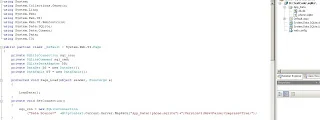C# Simple operation SQLite & Asp.net
SQLite is an embedded SQL database engine. Unlike most other SQL databases, SQLite doesn't have a separate server process. SQLite reads and writes on to ordinary disk files. an entire SQL database with multiple tables, indices, triggers, and views, is contained during a single computer file. The database file format is cross-platform – you'll freely copy a database between 32-bit and 64-bit systems or between big-endian and little-endian architectures. These features make SQLite a well-liked choice as an Application File Format. consider SQLite not as a replacement for Oracle but as a replacement for fopen()
This is what I want for an extended time. Working with asp.net and database all the time I needed something like this. Before I had to use office access but it's not good for the work I want to try to do.
After a while I found SQLite and now I start using it in my private, demo, test projects. For now, I'm very satisfied with it.
Simple front design:
First, we need to copy some line of code in our web config project file:
Then we need to write the connection string :
using System;
using System.Collections.Generic;
using System.Linq;
using System.Web;
using System.Web.UI;
using System.Web.UI.WebControls;
using System.Data.SQLite;
using System.Data.Common;
using System.Data;
using System.IO;
public partial class _Default : System.Web.UI.Page
{
private SQLiteConnection sql_con;
private SQLiteCommand sql_cmd;
private SQLiteDataAdapter DB;
private DataSet DS = new DataSet();
private DataTable DT = new DataTable();
protected void Page_Load(object sender, EventArgs e)
{
LoadData();
}
private void SetConnection()
{
sql_con = new SQLiteConnection (“Data source=”+HttpContext.Current.Server.MapPath(“App_Data\phone.sqlite”)+”;
Version=3;New=False;Compress=True;”);
}
private void ExecuteQuery(string txtQuery)
{
SetConnection();
sql_con.Open();
sql_cmd = sql_con.CreateCommand();
sql_cmd.CommandText = txtQuery;
sql_cmd.ExecuteNonQuery();
sql_con.Close();
}
private void LoadData()
{
SetConnection();
sql_con.Open();
sql_cmd = sql_con.CreateCommand();
string CommandText = “SELECT * FROM phonebook”;
DB = new SQLiteDataAdapter(CommandText, sql_con);
DS.Reset();
DB.Fill(DS);
DT = DS.Tables[0];
GridView1.DataSource = DT;
GridView1.DataBind();
sql_con.Close();
}
private void Add(string name,string number)
{
string txtSQLQuery = “insert into phonebook (name,number ) values (‘” + name + “‘,’”+number+”‘)”;
ExecuteQuery(txtSQLQuery);
LoadData();
}
private void Delete(string name)
{
string txtSQLQuery = “delete from phonebook where name=’” + name + “‘”;
ExecuteQuery(txtSQLQuery);
LoadData();
}
protected void Button1_Click(object sender, EventArgs e)
{
Add(TextBox1.Text, TextBox2.Text);
}
protected void Button2_Click(object sender, EventArgs e)
{
Delete(TextBox3.Text);
LoadData();
}
}




